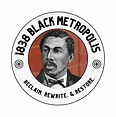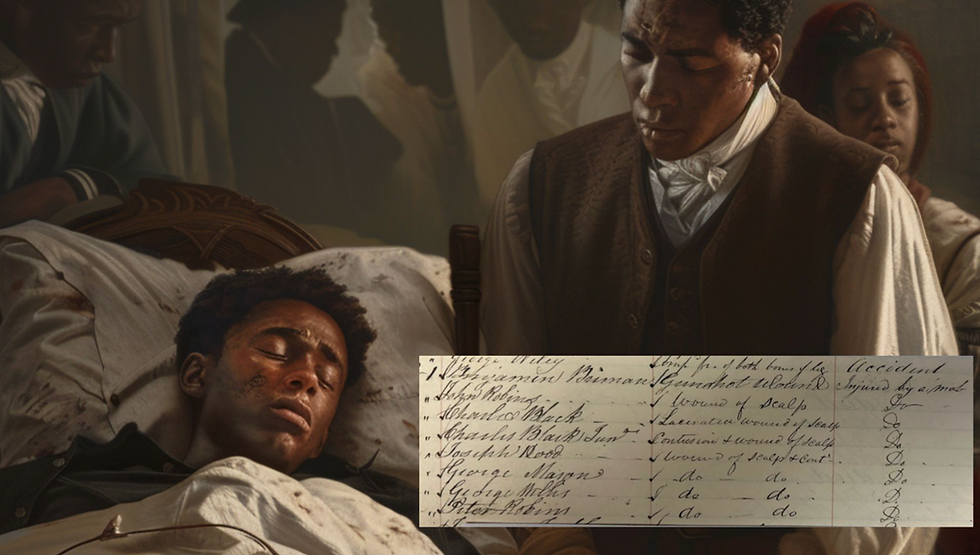Finding Victims of the 1834 and 1842 Mob Attacks in the Archives
- Michiko

- Aug 28, 2023
- 6 min read
Updated: Jun 16, 2024
The most miraculous thing that has happened to me this year was when my co-Founder Morgan Lloyd started lifting people out of the records from 2D written form into 3D physical people.
She literally goes into William Still's Underground Railroad, which records the arrivals of Freedom Seekers into Philadelphia, and prompts the AI to create a picture. She then posts to Instagram on the same day that person arrived. Here's an example.
Our focus here at the 1838 Black Metropolis has always been to connect and hear from the people of the Metropolis and let them guide us in the stories they need to tell about what they built. Today's story is one of those, though it's not an easy one.
Attacks on The Black Metropolis
The 1838 Black Metropolis was an existential threat to what I call the 'slave empires' just 100 miles South of it. A city of 20,000 free Black people building multiple institutions, generating wealth, building connections (maybe coalitions) globally and most importantly welcoming and providing sanctuary for freedom seekers completely undermines any scientific racism theoretical justifications for holding millions of Black people enslaved. I believe the slave empire recognized The Black Metropolis as a major threat to their own interest as a state entity and began multiple campaigns to destabilize free Black people in the North. IMHO.
There were multiple attacks in the 1830s and 1840s on the community. This story centers around the 1834 attack nicknamed 'Flying Horses' because the violence began at a carousel.

Thus I imagine that on a sunny day in early
August 1834, Stephen James took his children to the carousel at the corner of 7th and South street. Carousels were called 'Flying Horses' in those days.
Finding Stephen James
Stephen James was 50, married with two small children. I know his age because of an incredible visit to Penn Hospital where I had the pleasure of meeting with Curator and Lead Archivist Stacey Peeples, who gave me a personalized tour and welcomed me into her office, in the oldest part of the building, built in 1754. It was what you expect: low ceilings, doors with old fashioned latches, shelves from floor to ceilings stuffed with books and manuscripts that looked hundreds of years old.
This mob attack has been framed as a "race riot" but it wasn't a one day rising of seething anger that had reached a boiling point. I mean, that's what you think of when you hear 'riot'. Instead, It was 4 days of planned attacks on Black institutions and Black families. Many of the news articles and first person reports described organization; groups of white man wearing the same outfit, white people who knew to put candles in their windows to avoid attacks, meeting in a pre-planned way with weapons, leaders who used the word 'hunt' to embolden their followers to be as violent as possible. This reads more like a coordinated campaign of terror.
We've put together this walkthrough of those 4 days, along with the news reports, here.
I looked for information on Stephen James everywhere - but he's not in city directories and he died too early to be in the 1838 Black Census. That lead me to Penn Hospital admissions records and to Stacey.
Stacey bought out a large book of admissions and discharges from 1834. When you open the book admissions are on the left, discharges on the right. Across the top are columns, and there is one column for Black people labeled 'col' for 'colored'. Notably there were quite a lot of Black seamen, I would say about half of the people admitted were seamen. And they had baddd injuries lordt. Like fractures.

I counted 67 Black people admitted to Penn Hospital in 1834. August was the only month where 100% of those admitted had cuts and fractures, with no diseases. Based on their dates of admittance, I'm assuming these were victims of the mobs.
Stephen James was one of them.

They were:
Issac Christian, 40, Married. Admitted on August 13. He had a "wounded scalp" due to a "recent accident". Released on August 14th.
Stephen James, 50, Married. Admitted on August 14th. He had an "injured head" due to a "recent accident.". He died in the hospital on August 24th.
Joseph Sebastian, 23, Married. Admitted on August 19th. He had a "fractured skull" due to a "recent accident". Released on August 23rd.
I gasped audibly seeing his name in the book. It was like it all just became so very real. Here was this older man, my age. He was probably in bed when the mob came because we know that on August 13, the mob purposely began their attacks late at night. He probably was admitted early in the morning on August 14.
There are quite a few reports about the death of Stephen James. He was beaten to the point of death in front of his wife and children on Baker Street (now Pemberton) during the he 1834 Mob Attack on the Black community. This level of violence shocked Philadelphia and so it was in all the newspapers and in the official report by the committee investigating the cause of the riots.
An Abolitionist Englishman named Edwin Abdy went to the scene of his death and described it.


I think it's this description honestly that drove me to find out more about Stephen James, and to make his name known to all of you.
1842 Mob Attack Victims
I found more victims of mob attacks. The 1842 attack is currently called the "Lombard Street Riot" which is a misnomer (again). The mainstream narrative is that the riot was a flare up between Irish and Black workers over job competition.
But again, as with 1834, the mob targeted Black wealth and Black institutions and Black homes, not Black labor sites - you'd expect a riot over jobs to occur at an industrial site, not at church sites and private homes. And definitely not directed toward a parade of young peoples groups, marching for moral reform.
While the 1834 Penn Hospital admittance records attribute the cause of the injuries as "recent accidents", the 1842 records were immaculately clear. I think I want to thank whoever did that intake and I sense their desire for restorative justice as they purposely put in the record, "Injured by a Mob"

Here are their names. Note that I ran out of time and was unable to record everything and to dig into when/if they were discharged.
August 1, 1842 victims of the mob:
John Robins. 23. Injured by a Mob. Wound of scalp.
Peter Robins. 17. Injured by a Mob. Wound of scalp and contusions.
Charles Black. 48. Injured by a Mob. Laceration wound of the scalp.
Charles Black, Jr. 14. Injured by a Mob. Contusions and would of scalp.
Joseph Hood. 22. Injured by a Mob. Wound of scalp and contusions.
George Mason. 34. Injured by a Mob. Wound of scalp and contusions.
George Wilkes. 25. Injured by a Mob. Wound of scalp and contusions.
Louisa Wilkes. 22. Injured by a Mob.
James Fetterman. 47. Injured by a Mob.
William Quastine. 28. Injured by a Mob.
Isaac Reed. 65. Injured by a Mob.
Frances Draper. 30. Injured by a Mob.
William Ridgely. 20. Injured by a Mob.
I imagine a very busy 1842 ER, with staff scrambling to handle the number of people that just kept coming. Because at some point you'll note that the admittance clerk just put 'do' which means 'ditto'.
There are a number of younger people in this list and that's because it was the young peoples temperance and abolition groups that organized the temperance parade that was held ceremoniously on West Indian Emancipation Day: August 1.

This letter is from the Wesley church Sabbath School to one of the organizers of the parade, Jacob C. White. They are pledging the use of hymn books to be used by the parade participants and asking about the logistics of the day: "You will please inform us of the arrangements for the drilling of the schools for the singing."

'Temperance' is a 19th Century term for 'Sobriety'. The American Moral Reform Society was a Black organization that promoted living by a moral code that included physical and substance abstinence. In 1842, they were evidently so successful in helping people get and stay clean that they caused a greatly diminished revenue stream for liquor sellers in vicinity. This letter to the editor from The Liberator cites that as a reason for the attack on the parade. (also - shoutout to Dr. Bias).

Respect! This is really something to think about - a successful Black led and run movement to help people get and stay clean - way earlier than we've imagined. Read the proceedings of the 1843 Temperance Convention here.
Still there is a suggestion here. We should stop using the term 'race riot.' Black people weren't rioting, they were attacked. White mobs weren't just in-the-moment angry, they had organization and planning.
And we should frame the whole discussion from the viewpoint of the innocent, the people just trying to create spaces of sanctuary for thier families.
Learn More
If you really want to dig into the mob attacks, I would recommend the following:
Emma Lapsanky-Werner's article seeks to answer the question "Were there elements endemic to the creation or existence of certain institutions with the urban Black community that contributed to whites' selection of these institutions as targets for destruction?"
John Runcie's article that goes into detail about the composition and motivations of the mob.
Andrew Crocco's thesis that argues that the attacks were coordinated over years with an ultimate goal to move Black people out of the city center.







